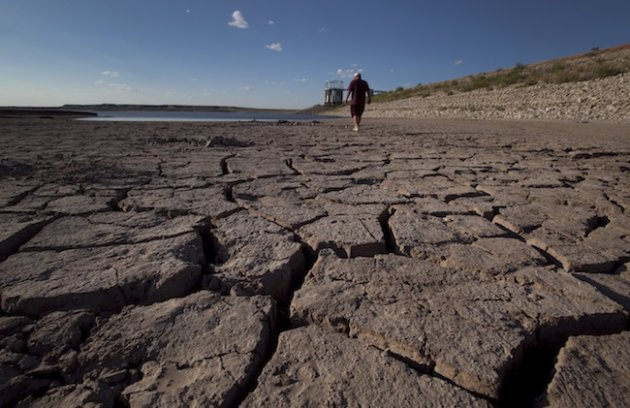Houston
The current drought map of the U.S., maintained by the federal government, shows a small amber blemish in the Southeast, indicating midlevel drought conditions, and a much, much bigger circular bruise in the middle of the country, shrouding virtually all of Texas and Oklahoma. Its dark purple-brown colors denote not just extreme drought, but "exceptional" drought.
This is no news for Texans. "It's like we've had a big 'H' [for high-pressure zone] parked over us all year, and we've had to watch the rainy weather rotate counterclockwise around Texas, like the spokes on a bicycle wheel," said Charles Joachim, the golf-course superintendent at Champions Golf Club in north Houston.
Houston, despite some people's impression of the Texas climate, is a semitropical city that averages about 50 inches of rain annually. This year so far it has received only 12 inches, 5 of which fell in January. More than 15,000 trees in the city's massive Memorial Park, including many lining the golf course there, are visibly dead or dying. (It will cost an estimated $4.5 million to remove them.) At the Tour 18 course north of the city, the hole meant to mimic the 17th at TPC-Sawgrass lacks one essential detail: water in the lake that surrounds the island green.
Miserly precipitation rates this year are only part of the problem facing Texas golf courses. The three-month stretch from June through August was the hottest that any state has experienced since at least 1895, when record-keeping began. Many parts of the state, including the Dallas-Fort Worth area, suffered through 70 days or more of 100-degree-plus weather. "At those temperatures, a course can lose over a third of an inch of moisture every day, just in evaporation out of the turf," said Charles "Bud" White, the U.S. Golf Association's regional agronomist. The combination of drought and heat can cause clay sublayers to expand, buckling cart paths and bursting buried irrigation pipes. (The horrifying wildfires that devastated nearly four million acres in Texas and destroyed more than 2,500 homes have pretty much left golf courses alone.)
Every region in Texas and Oklahoma is its own story, as is every golf course, but surveying how courses have coped with this drought, one thing stands out: Without smart water management and contingency plans, many courses will fail if the drought continues for another year or two.
Even courses with access to sufficient water may find the cost prohibitive. Champions in Houston, co-founded and still owned by two-time major champion Jackie Burke, in normal years gets most of the water it needs from rainfall (stored in its irrigation lakes) and from a local treatment plant that recycles waste water. Both sources are basically free, except for the cost of the pumping. This year, however, the club has been forced to pump additional water from wells. To use this resource, Champions has to pay the local water district $1.75 per 1,000 gallons, which mounted to tens of thousands of dollars a month during the hottest, driest part of the summer. Those costs forced cutbacks in how much of the course the club irrigated and has resulted in the loss of several hundred trees, some of which the club had planted in the years since it opened in 1957.
To the west, by contrast, lack of supply is often the whole story. The semiprivate Quicksand Golf Course in San Angelo draws its water from the Concho River, but the flow was so low for much of the summer that course superintendent Logan Knapp was able to claim only about a quarter of the club's contractual allotment. (And even that was dangerous, since sucking the source dry could have caused $150,000 in damage to his pumping station.) He watered his greens every day, but the fairways and tees only twice a week. About 20 acres of turf died off.
Even that's better than the situation at the Territory near Duncan, Okla. The creek that is normally the water source for that course is bone-dry. Since June, using water purchased at great expense from a rural water district, superintendent Brad Babek has watered only the bentgrass greens, by hand.
The vast majority of courses in Texas and Oklahoma have been able—so far, at least—to finagle enough water to maintain good and even excellent playing conditions. The heat-loving Bermuda greens at Memorial Park in Houston, for example, are as slick as they've ever been, in part because of the absence of fungus and other turf diseases that often arrive in wet summers. In San Antonio, the Quarry and about 10 other courses which are hooked up to the city's recycled-wastewater system have had all the water they needed, since effluent water needs to keep flowing no matter what. Other courses in the San Antonio region that primarily pump from wells have had to make staged, percentage reductions in the water they consume.
Some prognosticators think the drought could last for several more years, but the short term is problematic, too. "The scary part is thinking about where we'll be six months from now if we don't get some good rain this fall," said Brian Cloud, regional representative for the Golf Course Superintendents Association of America.
Like squirrels gathering nuts, golf-course turf usually prepares itself for winter by storing carbohydrates in its root system. That doesn't happen when the grass is stressed or already dormant, as much Texas turf is this year. A severe winter also could kill off vulnerable turf. "Come spring, a lot of superintendents may have to find ways to manage their courses like they've never had to before," Cloud said.
—Email John Paul at golfjournal@wsj.com.
This is no news for Texans. "It's like we've had a big 'H' [for high-pressure zone] parked over us all year, and we've had to watch the rainy weather rotate counterclockwise around Texas, like the spokes on a bicycle wheel," said Charles Joachim, the golf-course superintendent at Champions Golf Club in north Houston.
Houston, despite some people's impression of the Texas climate, is a semitropical city that averages about 50 inches of rain annually. This year so far it has received only 12 inches, 5 of which fell in January. More than 15,000 trees in the city's massive Memorial Park, including many lining the golf course there, are visibly dead or dying. (It will cost an estimated $4.5 million to remove them.) At the Tour 18 course north of the city, the hole meant to mimic the 17th at TPC-Sawgrass lacks one essential detail: water in the lake that surrounds the island green.
Miserly precipitation rates this year are only part of the problem facing Texas golf courses. The three-month stretch from June through August was the hottest that any state has experienced since at least 1895, when record-keeping began. Many parts of the state, including the Dallas-Fort Worth area, suffered through 70 days or more of 100-degree-plus weather. "At those temperatures, a course can lose over a third of an inch of moisture every day, just in evaporation out of the turf," said Charles "Bud" White, the U.S. Golf Association's regional agronomist. The combination of drought and heat can cause clay sublayers to expand, buckling cart paths and bursting buried irrigation pipes. (The horrifying wildfires that devastated nearly four million acres in Texas and destroyed more than 2,500 homes have pretty much left golf courses alone.)
Every region in Texas and Oklahoma is its own story, as is every golf course, but surveying how courses have coped with this drought, one thing stands out: Without smart water management and contingency plans, many courses will fail if the drought continues for another year or two.
Even courses with access to sufficient water may find the cost prohibitive. Champions in Houston, co-founded and still owned by two-time major champion Jackie Burke, in normal years gets most of the water it needs from rainfall (stored in its irrigation lakes) and from a local treatment plant that recycles waste water. Both sources are basically free, except for the cost of the pumping. This year, however, the club has been forced to pump additional water from wells. To use this resource, Champions has to pay the local water district $1.75 per 1,000 gallons, which mounted to tens of thousands of dollars a month during the hottest, driest part of the summer. Those costs forced cutbacks in how much of the course the club irrigated and has resulted in the loss of several hundred trees, some of which the club had planted in the years since it opened in 1957.
To the west, by contrast, lack of supply is often the whole story. The semiprivate Quicksand Golf Course in San Angelo draws its water from the Concho River, but the flow was so low for much of the summer that course superintendent Logan Knapp was able to claim only about a quarter of the club's contractual allotment. (And even that was dangerous, since sucking the source dry could have caused $150,000 in damage to his pumping station.) He watered his greens every day, but the fairways and tees only twice a week. About 20 acres of turf died off.
Even that's better than the situation at the Territory near Duncan, Okla. The creek that is normally the water source for that course is bone-dry. Since June, using water purchased at great expense from a rural water district, superintendent Brad Babek has watered only the bentgrass greens, by hand.
The vast majority of courses in Texas and Oklahoma have been able—so far, at least—to finagle enough water to maintain good and even excellent playing conditions. The heat-loving Bermuda greens at Memorial Park in Houston, for example, are as slick as they've ever been, in part because of the absence of fungus and other turf diseases that often arrive in wet summers. In San Antonio, the Quarry and about 10 other courses which are hooked up to the city's recycled-wastewater system have had all the water they needed, since effluent water needs to keep flowing no matter what. Other courses in the San Antonio region that primarily pump from wells have had to make staged, percentage reductions in the water they consume.
Some prognosticators think the drought could last for several more years, but the short term is problematic, too. "The scary part is thinking about where we'll be six months from now if we don't get some good rain this fall," said Brian Cloud, regional representative for the Golf Course Superintendents Association of America.
Like squirrels gathering nuts, golf-course turf usually prepares itself for winter by storing carbohydrates in its root system. That doesn't happen when the grass is stressed or already dormant, as much Texas turf is this year. A severe winter also could kill off vulnerable turf. "Come spring, a lot of superintendents may have to find ways to manage their courses like they've never had to before," Cloud said.
—Email John Paul at golfjournal@wsj.com.


